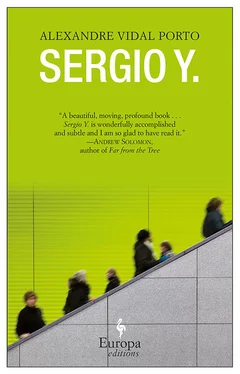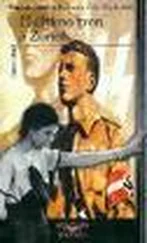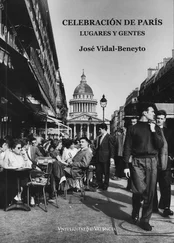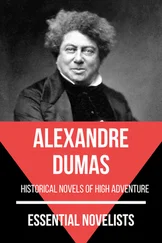Only once during Mass did my gaze cross paths with Tereza’s. She looked me straight in the eyes, quickly but deeply, for two seconds. Then she unlocked her eyes and stared off into infinity. At Mass, Tereza could see no one. There, the good I had done for Sergio Y. no longer mattered.
When Mass was over, before leaving, I went to the front of the altar to offer my condolences.
“Thank you for coming,” she said without looking up.
“I wouldn’t have missed it. I liked him very much,” I replied.
She took my right hand with both her hands. She shook her head sadly, always with her eyes downcast. I reached out to shake Salomão’s hand, and he greeted me formally, not quite sure who I was.
Before leaving the church, I felt an urgent need to wash my hands. At the sink in the bathroom next to the sacristy, with soapy hands, I had a near-hallucinatory event. Suddenly I had the impression that my hands were stained with blood. I felt blood on my palms, nails, and in between my fingers. Under the tap water, with plenty of soap, I slowly managed to remove that imaginary blood.
It was shortly after that I started having frequent nightmares, involving the various doubts that remained in my mind surrounding Sergio Y.’s death.
From the people I talked to — two friends of the family, who were also acquaintances of mine — I learned very little. I was unable to even learn the general circumstances surrounding what had happened. The only thing I knew was that he had been murdered. I still had no idea who the perpetrator had been or the reasons.
I thought about calling Tereza. I could perhaps extract from her information that would help satisfy the tremendous curiosity I felt concerning her son’s death, one that was beginning to trouble me.
Despite my desire to call, I did not. I could not be so brazen. I did not regret it. At the time, I did what seemed right, but the fact is I remained totally in the dark, knowing nothing about Sergio Y.’s murder.
My curiosity turned into an obsession. I spent hours on end creating different scenarios in my mind surrounding my former patient’s death. I dreamed of possible murderers, Sergio’s falling body, his terrified face, dressed as a chef, his head bleeding, covered in snow in the backyard of his home.
I began waking up in the middle of the night and lost my appetite completely. Two weeks after these symptoms began, an idea occurred to me as to how I might obtain answers to my most basic questions surrounding the case. My reasoning went as follows:
Sergio had been murdered in his home in the West Village. According to the article in the newspaper, Manhattan police had opened an investigation into the murder. Therefore, the answers I sought I would find in the outcome of their investigations.
Perhaps the police already knew the circumstances surrounding Sergio Y.’s murder. Who had killed him, and why. If the investigation had been completed, I might at least gain access to some of the answers.
The records of the alleged murder must reside somewhere in the Manhattan court system. If a suspect had been arraigned, there would also exist information concerning the court case. With any luck, there would even be transcripts of witness depositions. My curiosity about the circumstances surrounding the death of Sergio Y. would be satisfied in the New York courts.
The next day, while showering, after returning from the gym, something I already knew but had not thought of occurred to me: in the United States, information regarding court proceedings are public records. Therefore, anyone who files a formal request, even through a lawyer, can access information on any crime committed in the country.
I asked a cousin — the son of my aunt Yeda, with whom my mother had lived on Jauaperi Street — who works as a lawyer, if he knew a firm in the US that could help me obtain information about a homicide that had occurred in Manhattan.
“I’ll talk to our office in New York to see how we can do this. The crime was committed in Manhattan, right?” was the only question he asked me.
Two days after our conversation, my cousin called. He had spoken to the New York firm, and they recommended a private investigation agency, which could navigate the intricacies of the police bureaucracy and identify and select relevant information of interest to me in the case. The American lawyer with whom my cousin had spoken offered to request the information from the agency.
“It’ll set you back about two thousand dollars, but at least you’ll have no worries, and they’ll send you copies of all the files, everything aboveboard, I think it’s worth it. Here’s the e-mail of the guy in New York. Write to him, he’s waiting for you to contact him,” my cousin Jorge said.
Later that same day, I wrote to Oliver Hoskings. I asked for information concerning the possible murder of a Brazilian citizen, Sergio Y., on February 2, 2010, in the West Village.
I received an answer to my email about fifteen minutes later. Hoskings asked me to confirm the full name of the victim and that the death had occurred in the borough of Manhattan. I wrote to him confirming the information, and he promised to be in touch shortly.
Three days later, I received a message from Oliver Hoskings stating that there was no record of a murder or an attempted murder of a Sergio Emílio Y. in Manhattan on the date indicated. He asked if I would like to broaden the search to three days before and three days after February 2nd, which I agreed to.
He wrote to me again the next day. He said he could assure me that there was no death certificate for a Sergio Y. in Manhattan. However, he called my attention to a strange fact: another person with that same last name had been murdered on Grove Street in the West Village, on the day I had initially specified. He asked if I wanted information on that other individual. I was intrigued by the coincidence and said yes.
Of all the information that Hoskings forwarded me, the only facts that did not make sense were the first name (Sandra) and the sex (female) of the murder victim on Grove Street, on February 2, 2010. My American lawyer had managed to piece together a narrative from his search of the court records.
The body of Sandra Yacoubian was found facedown in a pool of her own blood by Edna Alves, a Brazilian maid. Ms. Yacoubian, born in São Paulo, Brazil, on January 10, 1988, was pushed from a fourth-floor window by a neighbor. She fell, broke her neck and bled to death in the backyard of the house she shared with her assassin at 12 Grove Street.
Shortly before her death, Sandra had been drinking, and there was evidence that she had been smoking marijuana too. She had been pushed out the window by the downstairs neighbor. The townhouse they had shared had been advertised in the market as “magnificent.” Sandra’s apartment occupied the top two floors. Laurie Clay, her murderer, occupied the bottom two.
Like Sandra, Ms. Clay was twenty-three years old. She studied fashion at New York University and wrote a style blog on the Internet. Her family came from Louisville, Kentucky, and she was the heiress of the largest mustard producer in the state. She surrendered voluntarily to police, five days after the crime.
Laurie claimed she had been under the influence of drugs and alcohol when she killed Sandra. That she had been ordered do to so by God, who had appeared to her in a hallucination. She was sentenced to twenty-two years in prison and was incarcerated at the Beacon Correctional Facility in the town of Beacon, about 100 kilometers north of New York.
At Hoskings’s suggestion, a search was done to determine whether there was in the civil records of New York anything indicating that Sergio Emílio Y. had, at some point, changed his identity.
That is how I discovered that Sergio Y. and Sandra Yacoubian were the same person. Or rather, that they were distinct branches of the same body. Sergio, who had acquired American citizenship thanks to an investor visa, formally filed a request in August 2009 to change his name and gender in a Manhattan court, which recognized the request and authorized the change. The grounds given for the request was “transsexuality.”
Читать дальше












